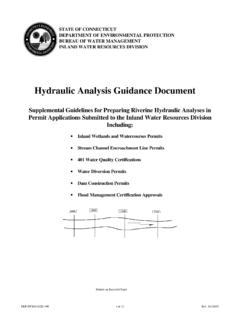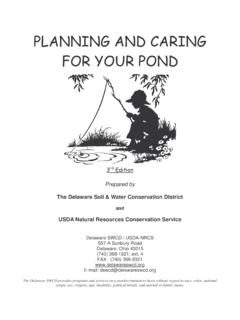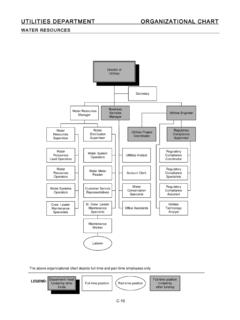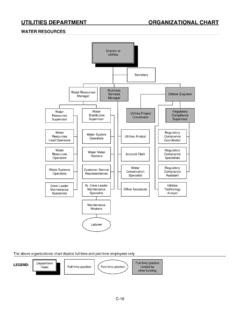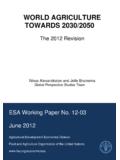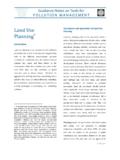Transcription of Connecticut Department of Environmental Protection
1 Connecticut Department ofEnvironmental ProtectionArthur J. Rocque, for Inspection and Maintenance of DamsSeptember 2001 Department of Environmental ProtectionBureau of water ManagementInland water Resources Division(860) 424-3706 Arthur J. Rocque, K. StahlCommissionerDeputy CommissionerRobert L. SmithCharles E. Berger, ChiefDirectorDenise RuzickaWesley D. MarshAssistant DirectorSupervising, Environmental AnalystACKNOWLEDGMENTSFrom this project s inception through its publication, I had the opportunity to work with Phil Moreschiand Jim Otis of Fuss & O Neill, Inc., who must be thanked for their patience, diligence and profession-alism in preparing this manual.
2 I also want to acknowledge the support of Charles Berger, Jr., Directorand Denise Ruzicka, Assistant Director of the Inland water Resources manual would not have seen the light of day without the contribution of Wesley Marsh, Supervisorof the Dam Safety Section. His intelligence, honesty, practicality and comprehensive knowledge ofConnecticut s dams have been , I would like to acknowledge the contribution of David Majachier. Nearly a decade ago, whileworking for the Dam Safety Section, he envisioned what I hope we have accomplished with thismanual.
3 With great appreciation and respect, this manual is dedicated to KuzykProject ManagerThe Department of Environmental Protection is an affirmative action/equal opportunity employer, providing programs andservices in a fair and impartial manner. In conformance with the Americans with Disabilities Act, DEP makes every effortto provide equally effective services for persons with disabilities. Individuals with disabilities needing auxiliary aids orservices, accommodations to participate in a listed event of for more information by voice or TTY/TTD call (860) forInspection and Maintenance of DamsPrepared forConnecticut Department of Environmental ProtectionBureau of water ManagementInland water Resources DivisionPrepared byFuss & O Neill, Hartford RoadManchester, CT 06040(860)
4 646-2469 This document was printed on recycled and ScopeImportance of Dam Maintenance and SAFETY REGULATIONS, OWNER RESPONSIBILITYAND LIABILITYDEP Dam Safety Program OverviewPertinent Statutes and RegulationsHow Dams are ClassifiedOperation and Maintenance Plan RequirementsInspection RequirementsResponsibility and OF DAMS AND OF FAILURES eepage/PipingOvertopping/ErosionStructur alProblems, Consequences, Recommended MAINTENANCEE mbankmentSpillwaysIntake/Outlet StructuresMasonry and Rubble WallsMiscellaneous Safety and Access SUMMARY AND SCHEDULE ASSISTANCE AND EMERGENCY INFORMATIONWhen a Permit May Be RequiredWhen to Contact a Professional EngineerEmergency Operation PlanLocal Emergency Management RoleEmergency Telephone NumbersGLOSSARY OF TERMSAPPENDIXI nspection ChecklistTABLE OF CONTENTSAPPENDIXF unding for the development and publication of this document was provided by a grant from the FederalEmergency Management Agency in cooperation with the Association of State Dam Safety Officials.
5 Inpreparing this manual, similar publications from the States of Missouri and Colorado were valuable sources ofideas and and ScopeDams are barriers typically constructed across astream channel to impound water . Dams are man-made structures requiring routine inspection andmaintenance. Several dams fail every year due tolack of maintenance, and in most cases failure couldhave been manual was developed to assist and encouragethe many owners of small dams in Connecticut toinspect and maintain their dams on a regular basis. Itis intended to be a useful guide for owners to refer towhile performing these activities. By inspecting adam on a regular basis, and becoming familiar withthe structure, the owner can recognize importantchanges more readily over number of inspection and maintenance practicesfor various types of dams are covered, although anemphasis has been placed on earth and earth/ma-sonry structures since they are the most commontypes of small dams in of Dam Maintenance and InspectionImpact of Dam Failure: Dam failure may result in theloss of life, property and income.
6 The loss or signifi-cant lowering of a pond or lake impounded by a dammay cause hardship for those dependent on it for theirlivelihood or water supply. The loss of a dam mayalso alter existing wetlands and eliminate recreationalopportunities for swimming, fishing and boating. Thelikelihood of future residential and commercialdevelopment occurring both downstream of dams andadjacent to impoundments means that the potential forsuch losses will continue to grow over time. Adheringto the maintenance and inspection guidelines of thismanual is not only an important endeavor for damowners but also a legal Inspection: Regular inspection is vital to theproper care and maintenance of dams.
7 A regularinspection program is essential in preserving theintegrity of a dam and avoiding costly repairs. Damsare subject to erosion, corrosion, and deterioration bywind, rain, ice and temperature. water passing over,under and through dams can weaken these structuresover time. A regular inspection program should startjust after construction is completed and continuethroughout the life of a INTRODUCTIONDam FailureDEP Dam Safety Program OverviewThe Dam Safety Section of the Inland water Re-sources Division of the Connecticut Department ofEnvironmental Protection (DEP) is responsible foradministering and enforcing Connecticut s dam safetylaws.
8 The existing statutes require that permits beobtained to construct, repair or alter dams, dikes andsimilar structures and that existing dams, dikes andsimilar structures be registered and periodicallyinspected to assure that their continued operation anduse does not constitute a hazard to life, health Statutes and RegulationsThe dam safety statutes are codified in Sections 22a-401 through 22a-411 of the Connecticut GeneralStatutes (CGS). Sections 22a-409-1 through 22a-409-2 of the Regulations of Connecticut State Agen-cies (RCSA) govern the registration and safetyinspection of dams in Connecticut . A copy of thesestatutes and regulations are available from the DamSafety Section of the Inland water ResourcesDivision of the DEP by calling (860) Dams are ClassifiedDEP assigns dams to one of five classes according totheir hazard AA: negligible hazard potential dam which, ifit were to fail, would result in no measurabledamage to roadways, land and structures, andnegligible economic A: low hazard potential dam which, if itwere to fail, would result in damage to agriculturalland, damage to unimproved roadways, or minimaleconomic BB.
9 Moderate hazard potential dam which,if it were to fail, would result in damage to nor-mally unoccupied storage structures, damage tolow volume roadways, or moderate economic B: significant hazard potential dam which, ifit were to fail, would result in possible loss of life;B. DAM SAFETY REGULATIONS, OWNER RESPONSIBILITY AND LIABILITY minor damage to habitable structures, residences,hospitals, convalescent homes, schools, etc.;damage to or interruption of the use or service ofutilities; damage to primary roadways and rail-roads; or significant economic C: high hazard potential dam which, if itwere to fail, would result in the probable loss oflife; major damage to habitable structures, resi-dences, hospitals, convalescent homes, schools,etc.
10 ; damage to main highways; or great classification of a dam can change due tochanges in downstream development. As shown inthe chart below, 83% of dams in Connecticut fallwithin the negligible to moderate hazardous categorieswhile only 17% fall within the significant and highhazard and Maintenance Plan RequirementsDEP typically requires owners of Class B and Chazard classification dams to prepare individualOperation & Maintenance Manuals for their dams,while owners of Class A and BB dams are notroutinely required to do so. The DEP created thismanual in order to help the owners of Class A andBB dams inspect and maintain these lower hazardstructures.











